CBI: Have you been able to engage local healthcare practitioners?
ERIC SCHREIMANN: Yes, 100%. We’re in the process of building out a health and wellness page on our website. We work closely with some doctors who prescribe GLP-1 medications. These patients are then encouraged to work with a personal trainer at Club Fitness to learn how to exercise effectively.
Once the medication stops, you have to continue to live a healthy lifestyle, so we give them the tools to make that sustainable.
We’ve had a lot of success with some gastric bypass surgeons in St. Louis as well. Gastric bypass patients also need to learn how to exercise and continue to live a healthy lifestyle. We’ve partnered with hormone therapy clinics to promote the message about the importance of exercise.
We’ve put a full-court press on partnering with experts who provide other services for healthy lifestyles. We have a good relationship with Metabolic Meals here in St. Louis, who provide healthy, grab-and-go meal options so our members have access to nutritional food. We’ve also worked with nutrition supplement companies as well. We all share the same consumers, the same membership base, if you will, so it makes a lot of sense to collaborate with doctors and other healthcare providers.
CBI: Do you find most physicians receptive to your message?
ERIC SCHREIMANN: Some are very receptive, and some are not. Some doctors understand that exercise is preventative care, but others are still stuck in the past. We will continue to try to increase the number of partnerships with physicians in the St. Louis community, but you have to earn their trust, so they feel comfortable referring patients to us. We have personal trainers that understand what they’re doing. I have faith and confidence in them. Those in the medical field need to have that level of comfort and confidence that their client is going to a health club that takes care of them.
CBI: You were recently named to the board of the Disabled Athlete Sports Association (DASA), and one of your members competed at the 2024 Paralympics. How did you get involved with increasing access for the disabled?
ERIC SCHREIMANN: We had a member who was in a wheelchair, and he sent me a LinkedIn message saying, "I'm in a wheelchair. I see you doing these things with DASA, but there’s not a lot of equipment at Club Fitness to help me with my cardiovascular health, because I can't use my legs."
So, I worked with this member to find upright rowers and other equipment that use upper-body movement for cardiovascular purposes. We bought some of these machines and put them in all of our clubs.
We’re always seeking feedback from either our employees or our members to see what we’re doing well and what we can improve upon and use that information to improve our business model and overall operations.
CBI: How do you create a community presence with your clubs?
ERIC SCHREIMANN: This connection with the community comes from the bottom up, from employee engagement and feedback, and also from our members. We’re very involved in the community. We just renovated the weight room at an inner-city high school [Jennings Senior High and College Prep Academy] after I visited the school to donate equipment. I saw that their facilities were dilapidated, so I called other business owners in the St. Louis area to come together and renovate their weight room. It was awesome. We just had the ribbon cutting a few weeks ago.
We also just rolled out the PRIME program for our first responders. Under this program, police officers and firefighters enrolled in the academy can work out at any Club Fitness location for free.
CBI: What has been the response from the community?
ERIC SCHREIMANN: To go to the high school where these kids now have this amazing weight room is unbelievably rewarding. It feels great. We also started a scholarship program for the school, where we award two seniors $5,000 scholarships.
The community is very appreciative. To me, it’s important that we not just provide great facilities for exercise but go beyond our four walls to engage with the communities where our health clubs are located. We try to give back to the community as much as we can.
CBI: Other people who enter the fitness industry from the financial sector get hooked on seeing people improve their lives. Has that been your experience?
ERIC SCHREIMANN: Oh, 100%. Believe it or not, there are a lot ofsimilarities in the banking industry and the health industry. You’re helping people achieve their dreams, whether it’s financing a house or new business construction, and it’s rewarding to see those folks succeed in their careers.
It’s the same in the fitness industry, where we improve the quality of life for our members and employees. It’s deeply rewarding.



